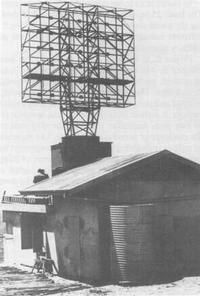


Chapter 13
I Colonial Origins
II First World War
III Between The World Wars
IV The Second World War
i Optical Munitions
ii Aircraft
iii Armour
iv Radar
v Tropic Proofing
V Post-second World War
VI After The Joint Project
VII Science And Decisions At The Top
VIII Armed Services Technology
IX New Tasks And Projects
X Transfer Of Research And Development
XI Acknowledgement
References
Index
Search
Help
Contact us

Radar
Scientists of the CSIR Radiophysics Division were quick to exploit the information about British radar developments, with innovative solutions to the Australian problems.[26] The primary initial requirement was to aid in the shore detection of hostile ships. As a result the first installation of its kind was erected at Dover Heights in Sydney for the use of the shore defence batteries at Dover and North and South Heads. Some of the novel features included its single scanning antenna array, which was used in both transmit and receive mode, the consequently necessary T-R switch invented in Australia for the purpose, and the beam-split adopted from the United Kingdom.
Several other devices were developed. One was a Search Light Control radar (SLC) attached to the 90 cm searchlight. It operated very successfully in Australia, but was not rugged enough for transport to and use in New Guinea. In any case it was overtaken by an unexpected supply of 150 cm British searchlights with radar attached. An airborne radar set was developed for the Beaufort bomber, but eventually a modified British set was adopted.
A government agency was formed to handle radar developments and the education of industry in the new technology. The Wireless Valve Company, then a subsidiary of AWA, Standard Telephones and Cables, Metal Manufacturers and the laboratories of the Post Master General participated in developments. One of the major achievements was the development of Australian Lightweight Air Warning set for deployment at ground stations in New Guinea.[27] This equipment was air portable and gained a high reputation for maintenance and reliability. The invention of the resonant cavity magnetron in the United Kingdom offered the opportunity to achieve higher accuracy and the detection of small targets such as submarines. The Physics Department of Melbourne University Investigated the technology of the magnetron, and samples were manufactured by the three companies mentioned above. A centimetric radar was deployed at South Head and at Point Turana on the South Coast of New Guinea.
Organisations in Australian Science at Work - CSIRO Division of Radio Physics; Metal Manufacturers Ltd; Standard Telephones and Cables (S.T.C.); Wireless Valve Company
 |
Australian Academy of Technological Sciences and Engineering |  |
© 1988 Print Edition pages 933 - 934, Online Edition 2000
Published by Australian Science and Technology Heritage Centre, using the Web Academic Resource Publisher
http://www.austehc.unimelb.edu.au/tia/914.html